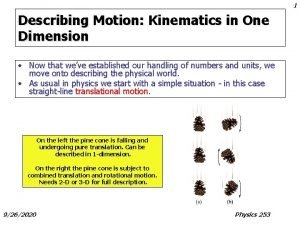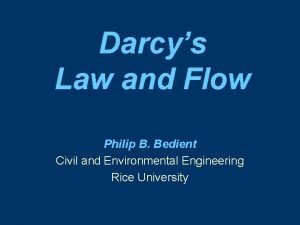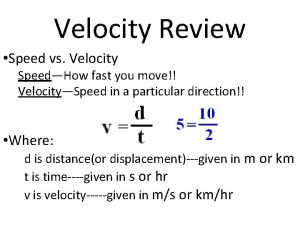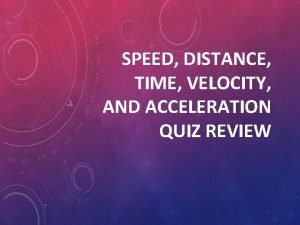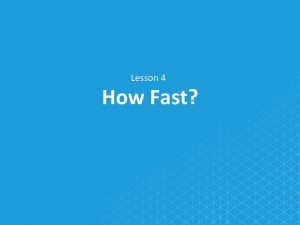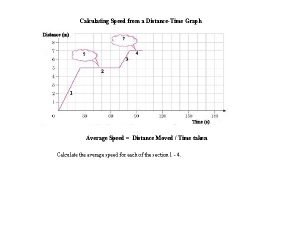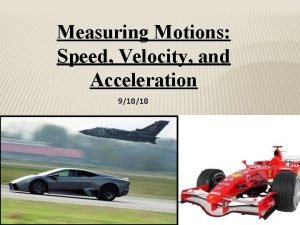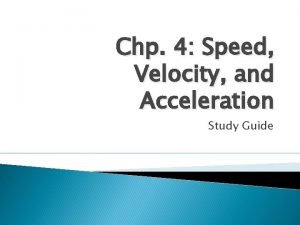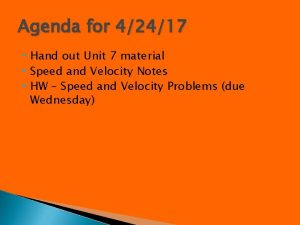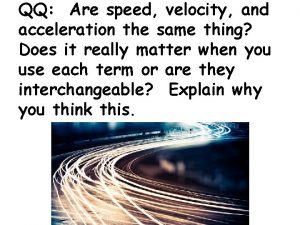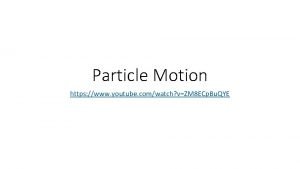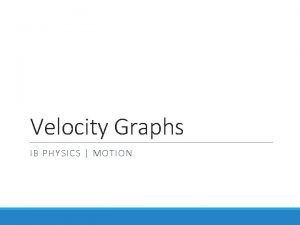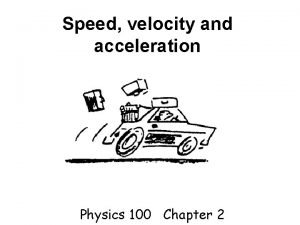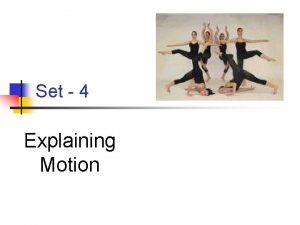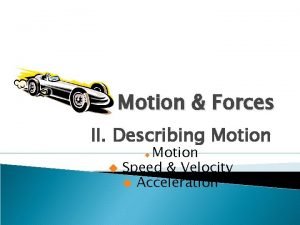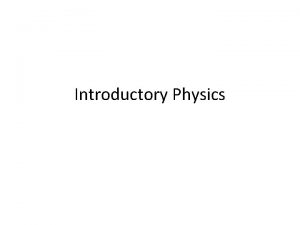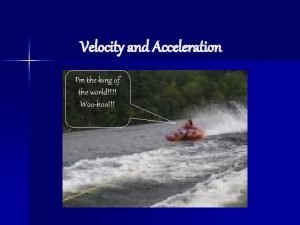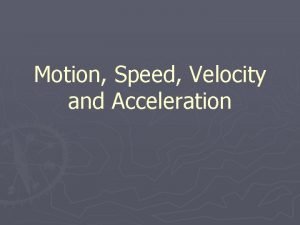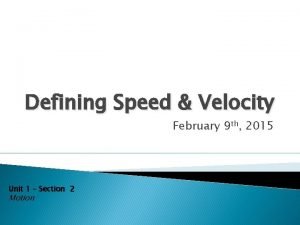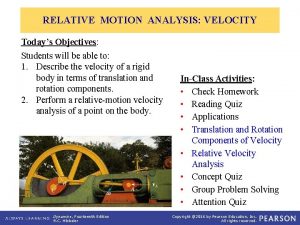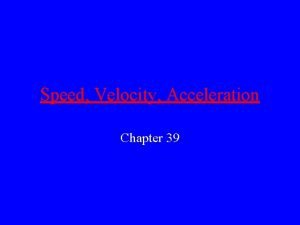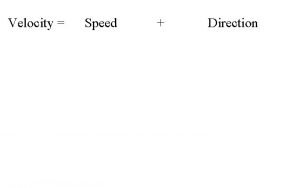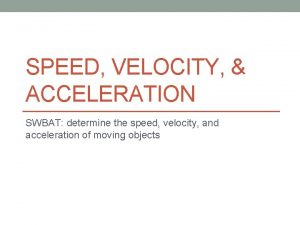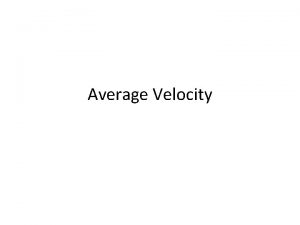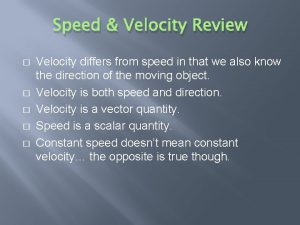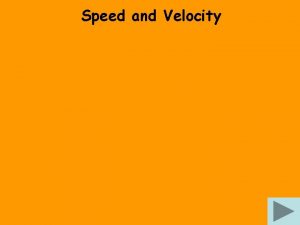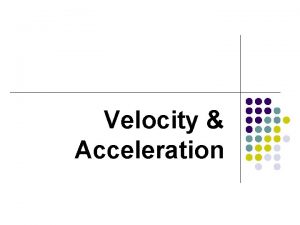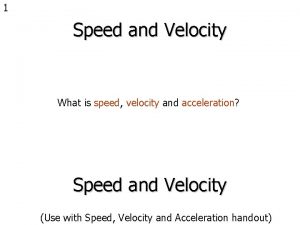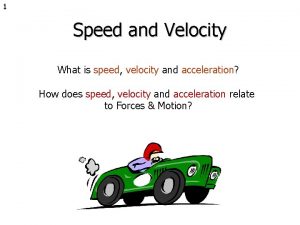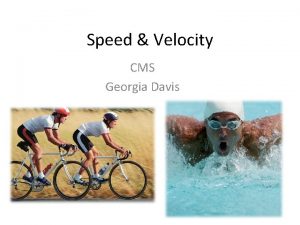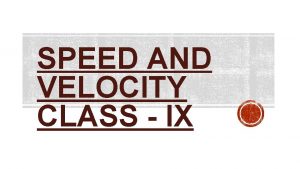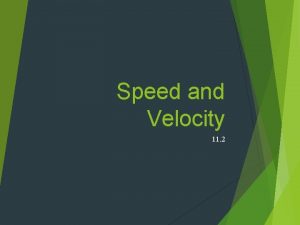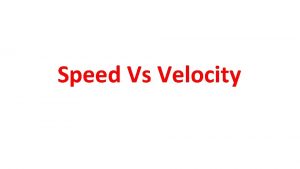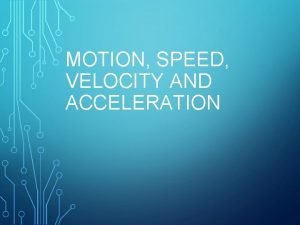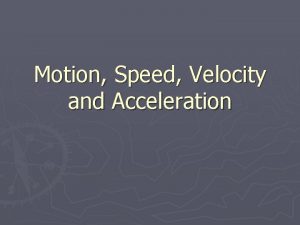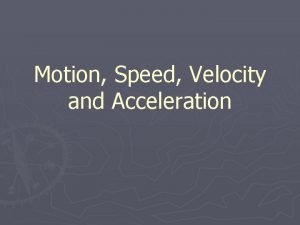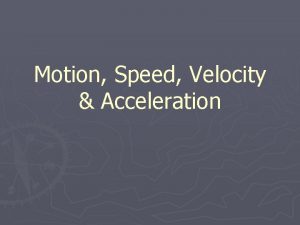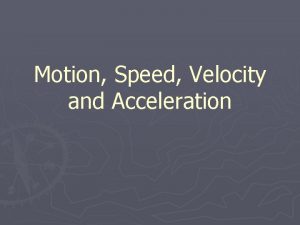MOTION SPEED VELOCITY CHAPTER 9 SECTION 1 MOTION















































- Slides: 47

MOTION, SPEED, & VELOCITY CHAPTER 9, SECTION 1

MOTION & DISTANCE An object is in motion if the distance from another object is changing. The object used for comparison to determine if something is in motion is called a reference point. Why is it important to select a stationary reference point rather than a moving reference point?

WHAT IS RELATIVE MOTION? ARE THE SKY DIVERS MOVING RELATIVE TO EACH OTHER? ARE THEY MOVING RELATIVE TO THE PLANE? ARE THEY MOVING RELATIVE TO THE GROUND?

REFERENCE POINT Suppose you are. . . Standing on the sidewalk. Describe your motion relative to the car and the plane.

REFERENCE POINT Suppose you are. . . Riding in the car. Describe your motion relative to the person on the sidewalk and the plane.

REFERENCE POINT Suppose you are. . . Riding in the plane. Describe your motion relative to the person on the sidewalk and the car.

DISTANCE Distance is the length of a path between two points. Can you state the distance between the two cars? A -10 -5 B 0 5 10 15 20 25

DISPLACEMENT Displacement is the length and direction an object has moved from its starting point, sometimes called position. Can you state the displacement of Car A? Can you state the displacement of Car B? A -10 -5 B 0 5 10 15 20 25

DISTANCE & DISPLACEMENT Imagine the number line has shifted left by 10. Has the distance between the two cars changed? Has the displacement of either car changed? A -20 -15 B -10 -5 0 5 10 15

DISTANCE VS. DISPLACEMENT What is needed to define displacement that is not in the definition of distance? This is what we call a ____________.

CHECKPOINT! The skier started at A, skied over to B, skied back to C, and finished at point D. What is the skier's displacement? What is the skier’s total distance traveled?

VOCABULARY Send a private message with the correct vocab words from the blanks below: 1. 2. 3. 4.

CALCULATING SPEED & VELOCITY CHAPTER 9, SECTION 2

SPEED & VELOCITY Speed is how distance changes in relation to time. Velocity is speed with a given direction! Vector Quantity has both Magnitude (size) & Direction. Speed has magnitude… not direction Velocity has magnitude & direction. Which is an example of a Vector Quantity?

INSTANTANEOUS SPEED If we are looking at any given point, we call it instantaneous. Instantaneous Speed the rate at which an object is moving at a given instant in time. Units: m/s Examples: A cheetah sprints 100 m in 4 seconds. What was its speed? After that, the cheetah sprints another 120 m in 3 seconds. What was its speed this time?

HOW WOULD WE DESCRIBE THE CHEETAH’S SPEED? VELOCITY?

AVERAGE SPEED Most objects do not move at constant speed, but are constantly changing. Average Speed is the total distance traveled by the total time. Units: m/s Example: Our physical science class takes a road trip to the Grand Canyon! It total we drove 500 miles, but with our stops for lunch and snacks, it took a total of 15 hours. What was our average speed? What is the cheetah’s average speed?

CHANGES IN VELOCITY ARE DUE TO CHANGES IN SPEED, CHANGES IN DIRECTION, OR BOTH!

GRAPHING MOTION & SLOPE Motion can be plotted on a graph by labeling the X-axis with TIME and the Y-axis DISTANCE. A point on a graph can show the location and speed of an object at a particular time. Those points are: x (time) y (distance)

Consider a car moving with a constant, positive velocity of 10 m/s. If the position-time data for such a car were graphed, the resulting graph would look this. • How did we describe the velocity? • How can we describe the line on the graph?

SLOPE Slope tells you how one variable changes in relation to the other variable or the rate of change. The slope of a distance versus time graph represents speed… the rate that distance changes in relation to time. Rise Divided by Run –or— Distance (y)/ Time (x)

MOTION PRACTICE 1 Download “Motion Practice 1. doc” from the Chapter Notes folder.

MOTION PRACTICE 1 Download “Motion Practice 1. doc” from the Chapter Notes folder.

MOTION PRACTICE 1 Download “Motion Practice 1. doc” from the Chapter Notes folder.

ACCELERATION CHAPTER 9, SECTION 3

ACCELERATION Let’s Review: What is Speed? What is Velocity? What is a Vector? Acceleration is the rate at which velocity changes Refers to INCREASING speed DECREASING speed CHANGING direction

IS ACCELERATION A VECTOR? A softball accelerates when it is thrown, hit, or caught. What change in motion occurs in each example? • Thrown- ball accelerates as it is thrown • Hit- ball changes direction • Caught- ball decelerates (negative acceleration) How can a car be accelerating if its speed is constant at 65 km/h?

The arrows are larger as the plane increases speed or accelerates …the arrows represent the vector quantity

The arrows are larger as the plane increases speed or accelerates …but what else is different? Think about distance covered!

CALCULATING ACCELERATION Final Velocity Acceleration = Final Velocity - Initial Velocity Time As a roller coaster starts down a slope, its velocity is 4 m/s. But 3 seconds later, its velocity is 22 m/s in the same direction. What is its acceleration? a = Vf-Vi t Initial Velocity Time

GRAPHING ACCELERATION • Speed vs. Time Graph • Upward means speed is increasing • Line is straight means acceleration is constant • A horizontal line (flat) would mean that the object is moving at a constant speed. • Slope on a speed vs. time graph represents acceleration

GRAPHING ACCELERATION Consider a car moving with a positive, changing velocity, that is, a car that is moving rightward but speeding up or accelerating.

VELOCITY VS. ACCELERATION A straight line on a graph is linear or has constant speed. A non-linear line illustrates increasing or decreasing speed

ENERGY CHAPTER 9, SECTION 4

ENERGY Energy is the ability to do work or cause change What is Transfer of Energy? • When an object does work on another object, energy is transferred. • When energy is transferred, work is done and an object gains energy. The SI Unit for both Work & Energy = Joule

KINETIC ENERGY Kinetic means motion – Kinetic Energy is the energy of motion Depends on the object’s mass § Which do you think contains more energy, a running elephant or running Chihuahua? Depends on the object’s speed § Which do you think contains more energy, an elephant running 1 mph or 100 mph? Kinetic Energy = ½ Mass x Speed 2 Kinetic energy increases as mass increases or if its speed increases.

MASS & SPEED Brain Pop!

POTENTIAL ENERGY Stored energy that results from the position or shape of an object. Object has the potential to do work. Two types: Gravitational § Like the force of gravity! Elastic § Like an elastic rubber band!

GRAVITATIONAL POTENTIAL ENERGY PEgravity = Weight x Height PEgravity = Mass x 9. 8 m/s 2 x Height Depends on the object’s mass § Which do you think contains more energy, a falling Hummer or a falling bike? Depends on the object’s height § Which do you think contains more energy, a penny dropped off your desk or a penny dropped off the Empire State Building?

MASS & HEIGHT 1. Does a skier have more gravitational potential energy on a 50 meter high jump or a 40 meter high jump? 2. What is the PEgravity of a skier that weighs 25 kg on a 40 m high ski jump?

ELASTIC POTENTIAL ENERGY Brain Pop! When an object gains potential energy because it is stretched or squeezed. What are some examples? Archer pulling back on an arrow changes the shape of the bow…the bow now has more potential energy that can be used to send the arrow flying

MECHANICAL ENERGY An object’s combined kinetic energy and potential energy This is the total energy in the system. Mechanical Energy = Kinetic Energy + Potential Energy

CONSERVATION OF ENERGY 1. When you throw an orange up into the air, what kind of energy increases as its height increases? 2. As the orange falls from its greatest height, what kind of energy increases and what kind of energy decreases?

CONSERVATION OF ENERGY

PENDULUM Watch the animated link. What happens to the Potential Energy? The Kinetic Energy? The Mechanical Energy?

ENERGY MATH PRACTICE

ENERGY GROUP WORK You are going to make picture flashcards for each of the following vocabulary words. Make sure to include the definition, an example, and a picture. Split up the work within your group or work together! No more than 2 words to a slide. Kinetic Energy Potential Energy Gravitational Potential Energy Elastic Potential Energy Mechanical Energy Law of Conservation of
 Chapter 1 lesson 2 speed and velocity answer key
Chapter 1 lesson 2 speed and velocity answer key Section 2 velocity and momentum
Section 2 velocity and momentum Chapter 2 section 1 describing motion answer key
Chapter 2 section 1 describing motion answer key Measuring motion
Measuring motion Section 1 describing motion
Section 1 describing motion Darcy kroeker
Darcy kroeker Angular quantities and linear quantities cannot be related.
Angular quantities and linear quantities cannot be related. Initial velocity and final velocity formula
Initial velocity and final velocity formula Is v final velocity
Is v final velocity Speed unit
Speed unit Instantaneous velocity vs average velocity
Instantaneous velocity vs average velocity Darcy velocity vs actual velocity
Darcy velocity vs actual velocity Angular velocity to tangential velocity
Angular velocity to tangential velocity Minimum velocity
Minimum velocity Velocity triangle
Velocity triangle Changes in velocity
Changes in velocity What is acceleration
What is acceleration Speed, velocity and acceleration quiz
Speed, velocity and acceleration quiz Speed velocity and acceleration problems answers
Speed velocity and acceleration problems answers Differentiate between average speed and average velocity
Differentiate between average speed and average velocity Light travels at 300 000 km/s
Light travels at 300 000 km/s Velocity v speed
Velocity v speed Increasing speed distance time graph
Increasing speed distance time graph What two measurements are necessary for calculating speed
What two measurements are necessary for calculating speed What's the difference between speed and acceleration
What's the difference between speed and acceleration Describes both speed and direction
Describes both speed and direction 21bwundoqno -site:youtube.com
21bwundoqno -site:youtube.com Speed velocity and acceleration study guide answers
Speed velocity and acceleration study guide answers Speed and velocity
Speed and velocity Are speed and acceleration the same thing
Are speed and acceleration the same thing Graph the particle's velocity and speed where defined
Graph the particle's velocity and speed where defined Reference point examples
Reference point examples What is velocity
What is velocity Speed vs velocity
Speed vs velocity Velocity and speed
Velocity and speed Speed and velocity difference
Speed and velocity difference Do heavier objects fall faster
Do heavier objects fall faster How to describe velocity
How to describe velocity Velocity describes both speed and
Velocity describes both speed and Speed and velocity
Speed and velocity Speed and velocity
Speed and velocity Graphs that compare distance and time are called
Graphs that compare distance and time are called Section 1 describing motion answer key
Section 1 describing motion answer key Section 1 describing motion
Section 1 describing motion Speed time and distance formula
Speed time and distance formula Strong emotions can interfere with your ability to
Strong emotions can interfere with your ability to Speed detection of moving vehicle
Speed detection of moving vehicle Relative motion analysis using rotating axes
Relative motion analysis using rotating axes










